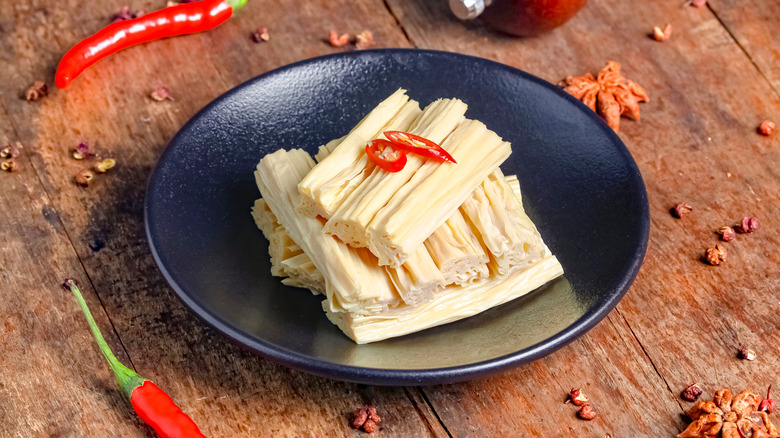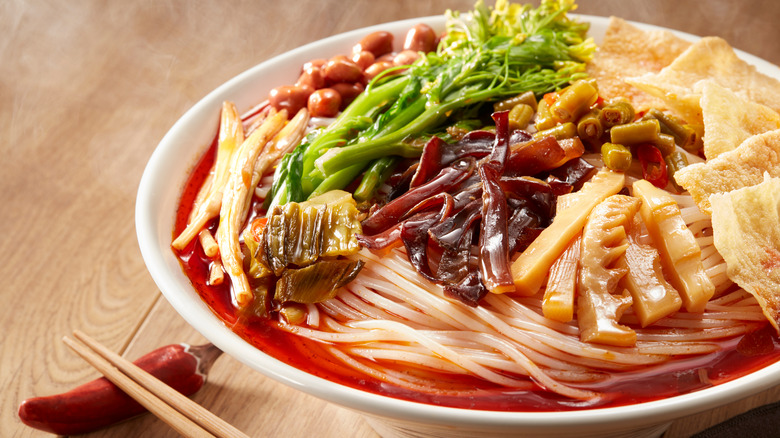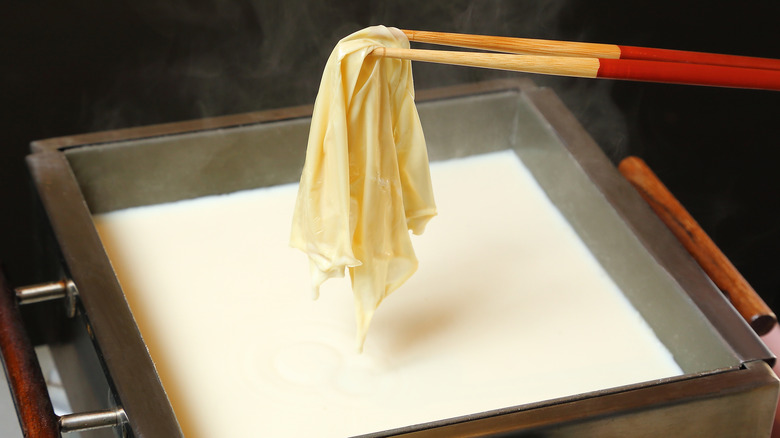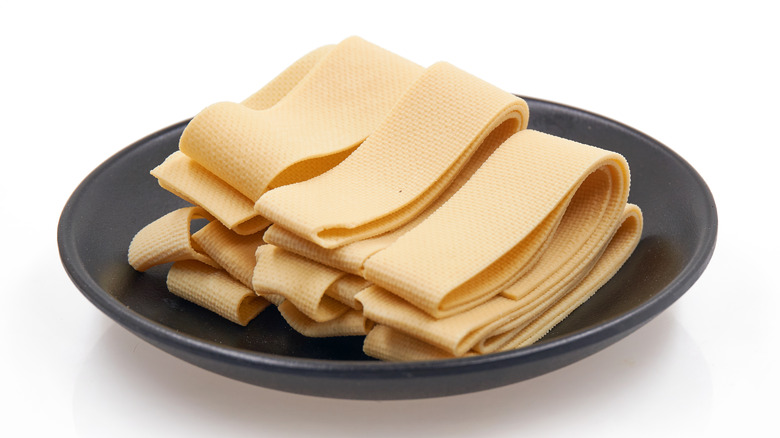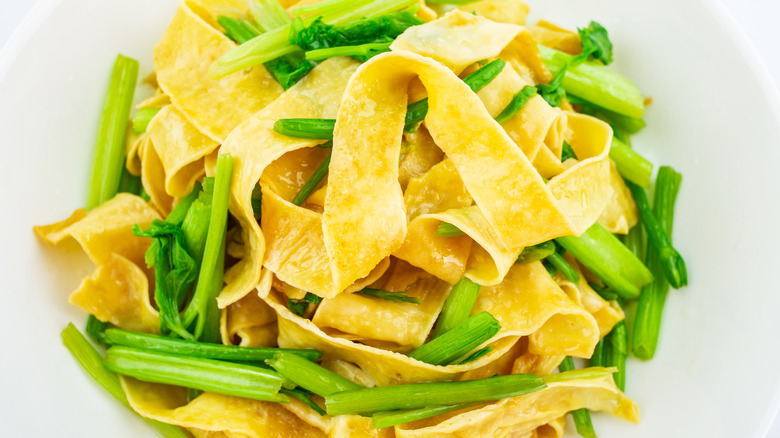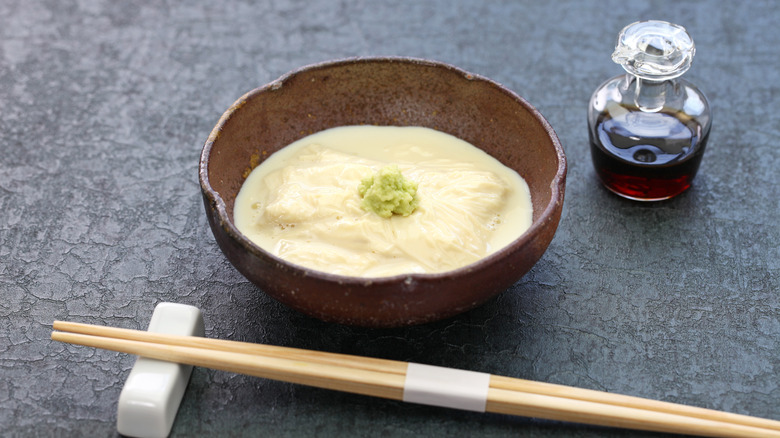What Is Yuba And How Do You Eat It?
If you have never heard of yuba, you're not alone. Though if you order takeout from your favorite Chinese or Japanese restaurant several times a month, chances are that you have actually tasted yuba, albeit disguised under a different name. Ever tried a portion of bean curd rolls during a dim sum meal? The stretchy and rubbery covering surrounding the filling is known as yuba, The Spruce Eats explains.
Much like the thin layer of skin that forms on top of milk when you boil it, yuba is the skin that forms on hot soy milk. When you bring a pot of soy milk to boil, you can then skim off the firm, congealed layer that appears on top and turn it into yuba, enjoyed as is or incorporated into dumplings, stews, and more. This yuba-making method is why the ingredient is often given the name of tofu skin. The rest of the boiled soy milk then becomes tofu.
What is yuba?
Although yuba has contentious origins, it is generally believed that the ingredient was originally eaten in China and then made its way to Japan through the cities of Kyoto and Shiga some 1,200 years ago, according to The Spruce Eats. Since then, it has become central to vegetarian cooking in both countries.
Yuba is an important ingredient in lo han jai or Buddha's Delight, a vegetarian stew of sorts that is often served on the first day of the Lunar New Year in China. "Jai" means Buddhist cuisine, explains Omnivore's Cookbook, which consists of many vegetables with minimal seasonings. In Japan, too, yuba often turns up in shōjin ryōri or "devotion cuisine," which is the Japanese term for a spiritual form of cooking developed and practiced by Buddhist monks (via BBC).
Despite yuba's importance in the Buddhist vegetarian cuisines of China and Japan, it is speculated that the ingredient gets its name from the term "uba," Japanese for old woman, per Traditional Kyoto. This is a hint at the wrinkled appearance of yuba or tofu skin, which can be similar to that of an older person's skin. Another idea is that yuba comes from "uha," or surface, indicating the way in which yuba is made by skimming the skin that forms on top of hot soy milk.
How is yuba made?
Unless you're in Asia or have a Chinese or Japanese grocery store near you, getting your hands on yuba might be tricky (though California-based Hodo does make yuba sheets and noodles). What you can do, however, is make yuba at home, even if it is a bit time-consuming. Begin by simmering a pot of soy milk over evenly low heat and skimming off the skin each time that it forms, a Bon Appétit article shares. One batch of soy milk can make multiple layers of yuba, and the first layer begins to form as soon as the soy milk reaches 165 degrees Fahrenheit.
Once the first layer is thick enough, you should then run a small knife around the edge of the yuba, separating it from the pot, then gently lift it up with your fingers and hang it over a rod-like structure to dry. From there on, it takes about 25 minutes for each sheet of yuba to form on top of the soy milk. Making yuba is a laborious process and does require a lot of patience. You also have to be very careful of the heat you put the soy milk through: too much and your yuba will be filled with air bubbles.
What does yuba taste like?
Much like the taste of tofu — which is also made from soy milk — yuba doesn't have a particularly strong flavor of its own beyond a subtle, nutty, milk-like taste, as The Spruce Eats describes, which makes it an excellent base that can absorb other flavors. Whether you eat it fresh or dried also makes a difference. When eaten fresh off the soy milk pot, yuba has an especially light and silky flavor that Taste compares to that of fresh cheese. When bought dried in the form of sheets or sticks, it packs less of a punch.
What really makes yuba interesting, though, is its chewy, elastic texture that mimics the outside of a ball of mozzarella or burrata. This sensation will be apparent when the yuba is fresh; if it's dried, it needs to be rehydrated in some water before being used in your cooking.
Nutritional information about yuba
Since yuba is derived from soy milk, it has many of the health benefits associated with soybeans. For starters, yuba can be a great source of protein for multiple diets: vegetarian, vegan, gluten-free, lactose-intolerant, low-carb, and grain-free, per On The Table. Of course, it cannot accommodate those allergic to soy. According to My Fitness Pal, a 1-ounce serving of yuba contains 7 grams of protein, about the same amount that most cooked meats contain (via Taste Of Home) — and at only 50 calories.
Besides being high in protein, soy-based staples like yuba have very little fat content, says Healthline. Plus, some studies suggest that soy can increase HDL (or good) cholesterol while reducing LDL (or bad) cholesterol, and high-protein diets may help with weight loss. Per Healthline, soybeans are also linked to helping reduce the risk of certain kinds of cancers, and the isoflavones they contain can help ease the symptoms of menopause for some women.
How to cook with yuba
While yuba doesn't have a strong flavor of its own, this is what makes it a great protein to add to many dishes, as it can easily absorb bold flavors. Considering yuba has an Asian origin, it fares particularly well in Chinese and Japanese cooking. Per Savvy Tokyo, fresh yuba, called nama yuba, is eaten in many forms. It could be yuba sashimi, dipped in some soy sauce and accompanied with wasabi. It can also be marinated in flavorful sauces and added to sandwiches, salads, and stir-fries. Otherwise, it can be cut into noodles, served on top of soups, or used as dumpling wrappers.
When rehydrated, dried yuba can be enjoyed in similar ways. Try it in place of rice paper to make spring rolls or in place of flour-based skins for fried wontons. Taste recommends pan-frying a sheet of rehydrated yuba, sprinkling some salt on top, and pouring sweetened condensed milk over it for "the ultimate pudding skin." If you're in the mood for something a tad more elaborate, you can try making lo han jai — the vegetarian Buddha's stew — at home using Taste of Asian Food's recipe.
